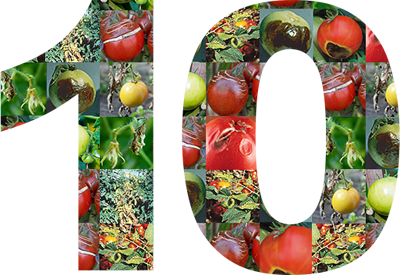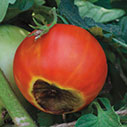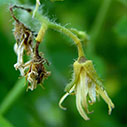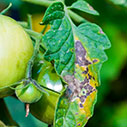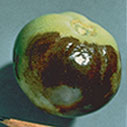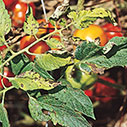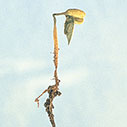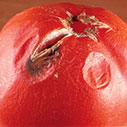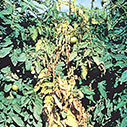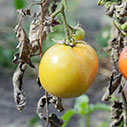Common Tomato Diseases
Nothing brings joy to gardeners and gourmets like flavor-packed, sun-ripened tomatoes. Throughout the country in the summertime, you'll find tomato plants growing in large gardens and raised beds—and you'll find this garden favorite growing in pots on sunny stoops, decks and porches. Gardeners have many varieties of tomatoes to choose from, and most have their favorite one or two or three. But the one thing most gardeners find frustrating is tomato plant diseases that can damage or destroy the plants and fruits. By learning more about the top 10 common tomato diseases and treatments, gardeners can successfully grow gorgeous, sun-ripened tomatoes.
Blossom End Rot

One of the most recognizable and treatable tomato diseases is Blossom End Rot. This common tomato disease usually occurs on the first fruits of the season or on tomatoes that ripen after a drought.
Identification:
Blossom End Rot can occur in ripe and green tomatoes. The fruits have dark blemishes or a black patch on the bottom, or blossom-end, of the fruit.
Blossom end rot is caused by a nutritional deficiency of calcium. Either the plants aren't getting enough calcium from the soil or the soil's pH is too low for the plant to adequately absorb the calcium. Tomatoes perform best when the soil pH is about 6.5. A soil test provides information about your soil's pH level and calcium levels. If calcium levels are inadequate, you can add crushed egg shells or a calcium supplement such as Enz-Rot™ Blossom-End Rot Concentrate Spray. Because inconsistent soil moisture makes plants susceptible to blossom end rot, keep the tomato roots moist, not wet. Mulching around the plants and watering deeply during droughts can help. Avoid deeply cultivating around the plants, as this can damage the roots and affect the plant's moisture intake.

Treatment:
Although blossom end rot doesn't spread from plant to plant, remove affected fruits from the plants. Mulch around the plants and provide consistent moisture (about 1 inch of rainfall weekly).
Blossom Drop

Blossom drop happens when the yellow flowers on the tomato plants dry up and don't form fruits. It's usually caused by weather-related factors.
Identification:
Blossom drop is fairly easy to identify. If a tomato blossom is pollinated, then the fruit begins to form. If it's not, then the yellow flowers dry up and fall off the plants. Blossom drop is usually caused by too cold or too hot weather, such as:
- Nighttime temperatures below 55 degrees F.
- Several days of 90-plus degree days and nighttime temperatures above 72 degrees F.
- Humidity levels above 70 percent or below 40 percent
- Strong winds
It can also be caused by too little or too much nitrogen or insect damage.
When planting tomatoes, make sure to wait until the temperatures have warmed up in the spring. If you live in an area with consistently hot temperatures, consider selecting tomato varieties that are more heat-tolerant. Good cultural practices, such as mulching the plants and providing adequate water and fertilizer also can help.

Treatment:
Pay attention to the weather patterns in your area. If blossom drop is a consistent problem year after year and temperatures regularly exceed 90 degrees, consider using shade cloths to shade your tomato plants from hot afternoon sun. Also, consider planting tomatoes that can handle the heat, such as Arkansas Traveller as well as some other favorites for southern gardeners.
Fruit Cracks
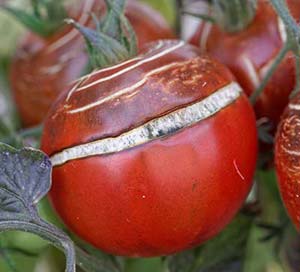
Although not technically a tomato disease, fruit cracks are a common problem for gardeners. While the tomatoes are still edible, they are unattractive and can also invite pests and birds to attack the fruits. Usually, cracking fruits happens when hot, rainy weather follows a dry spell. The plants take in water too rapidly, causing the fruits to swell and develop cracks.
Identification:
Fruit cracks occur in two patterns. The cracks are concentric circles starting at the top of the fruit or the fruit has vertical cracks.
While you can't control the rain, you can follow good cultural practices. Mulch around your tomato plants and water the tomato plants evenly during dry spells. This may keep the plants from taking in too much water all at once.

Treatment:
When fruit crack happens, harvest the tomatoes immediately. Don't allow them to rot on the vine and drop to the ground. Tomatoes left to rot on the ground can invite disease.
Early Blight
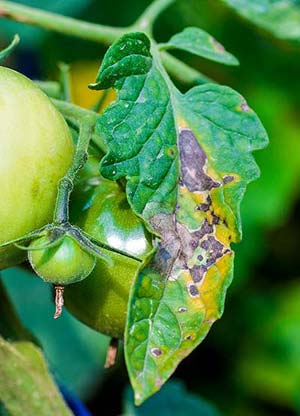
Early blight is one of many fungal diseases that can damage your tomato plants. This common fungal disease affects tomatoes as well as other nightshade plants, including potatoes and eggplants. The fungus affects the leaves, but can also damage the stems and fruits—and reduce yields.
Identification:
The first symptoms of an early blight infection are usually small, dark spots on the leaves at the bottom of the tomato plant. Rings start to form around the leaf spots and the tissue around the spots starts to yellow. Eventually the leaves turn brown and fall off the plant. This can leave the plants with very few leaves. The stems and fruits may also be affected.
Good gardening practices can help reduce the incidence of early blight infection. This includes:
- Practice crop rotation and don't plant tomato plants where tomatoes, potatoes, peppers or eggplant grew the previous two years.
- Pull up "volunteer" tomato plants, as they may harbor the disease.
- Plant blight-resistant cultivars.
- Use drip irrigation. Overhead watering can spread the spores and leave the plants wet.
- Stake tomato plants so they have plenty of air circulation.
- Pull up tomato plants and remove them from the garden in the fall.

Treatment:
Fungicides, such as Soap-Shield® Flowable Liquid Copper Fungicide, are available to treat early blight. When using a fungicide, be sure to follow label directions.
Late Blight
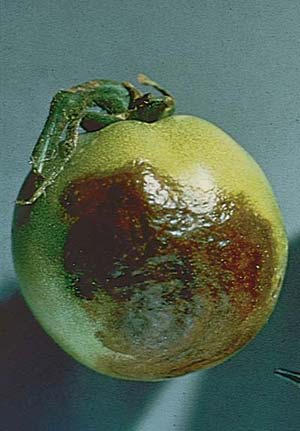
Late blight is one of the most devastating fungal diseases that infects tomatoes (and potatoes). The infection can quickly spread from the leaves to the fruits and destroy the plants, and this fungus seems to really take off during cool, wet weather. Late blight was the cause of the Irish potato famine in the 1840's.
Identification:
Late blight symptoms start as large, dark brown spots, edged in gray-green, on the leaves. The fungus spreads through the plant and to the fruits, leaving brown, mushy spots. The lesions on fruits affected by late blight tend to be lighter colored, brown or tan, than lesions on fruits affected by early blight. Late blight can infect all tomato plants within a matter of days. Infected plants often look like they've been damaged by frost.
As gardeners, we can't control cool, wet weather which usually brings on late blight. However, good gardening practices may help. Some good practices to follow include:
- Rotate crops. Don't plant tomato plants where tomatoes, potatoes, peppers or eggplant grew the previous two years.
- Water plants at their base. Avoid overhead watering and avoid handling the foliage when it's wet.
- Stake tomato plants and space them so they have plenty of air circulation.
- Pull up tomato plants and remove them from the garden in the fall.

Treatment:
Immediately remove any tomato plants showing signs of late blight. Fungicides, such as Soap-Shield® Flowable Liquid Copper Fungicide, are the most effective treatment for late blight. When using a fungicide, be sure to follow label directions.
Septoria
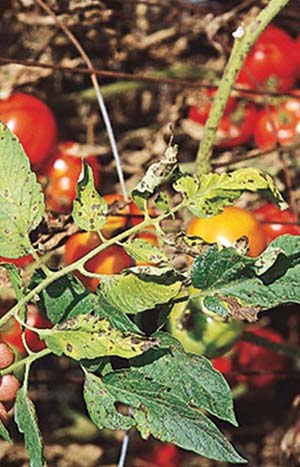
Another destructive fungal disease, septoria, also called septoria leaf spot, is common in wet, humid areas. The fungus damages the foliage on tomato plants and can drastically reduce yields.
Identification:
Septoria leaf spot first appears as small lesions or spots on the lower leaves and stems of the tomato plant. While septoria lesions are usually smaller than early blight lesions, septoria can quickly blight leaves and move to other areas of the plant. Once it spreads to the rest of the plant, it will weaken the plant and cause serious damage.
As with other tomato diseases, good garden practices can help prevent septoria. Some preventative steps include:
- Practice crop rotation and don't plant tomato plants where tomatoes grew the previous two years.
- Use drip irrigation and avoid overhead watering.
- Avoid handling the leaves when they are wet.
- Stake tomato plants so they have plenty of air circulation.
- Mulch around the tomato plants, and don't allow tomato leaves to have direct contact with soil.
- Monitor your tomato plants often and remove infected plants from the garden.
- Pull up tomato plants and remove them from the garden in the fall.
- Sanitize garden tools to keep from spreading disease to other plants.

Treatment:
Some fungicides are effective for treating septoria. Before use, make sure to read the label and see if the fungicide can be used for septoria leaf spot and follow label guidelines.
Damping Off
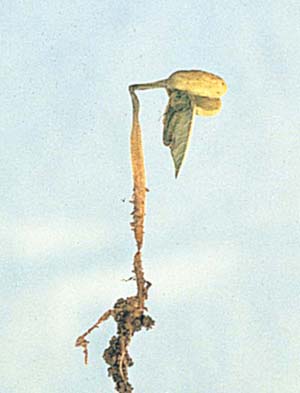
Damping off is a disease that affects germinating seeds and seedlings, especially in indoor seed-starting situations. However, it can also happen if direct sowing tomatoes into cold, wet garden soil. Caused by fungus or mold, damping off causes the seedlings to rot.
Identification:
If the seedlings fail to emerge from the soil, it may be caused by damping off. Other signs of damping off are soft, mushy and discolored seedling stems and wilting, gray-brown seedling leaves. The young seedling may also have white-cobweb looking growth around it.
Because damping off is caused by pathogens in the soil, follow good gardening practices when starting seeds. These include:
- Sterilize used seed-starting pots and trays before using them.
- Use new potting mix and don't use compost or garden soil for seed-starting.
- Clean and sterilize garden tools.
- If direct-seeding tomato seeds into the garden, wait until the soil temperatures warm to 70 degrees F.
- Make sure your seedlings have good drainage.

Treatment:
Because there is no treatment for damping off, take preventative measures when starting your tomato plants.
Anthracnose
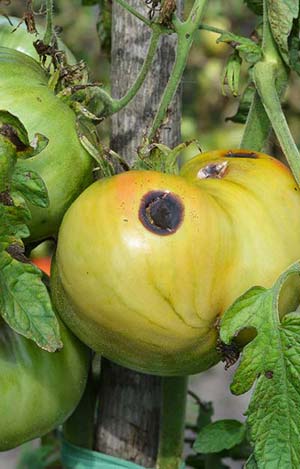
Another common fungal disease is anthracnose. Unlike many other fungal diseases, anthracnose damages the fruits, not the plants. Black spots start to develop on ripe and just-harvested fruits. The spots grow quickly, causing the fruit to rot.
Identification:
Anthracnose on tomatoes starts as small, dark spots that are slightly depressed. The spots grow in size and often have a pattern of concentric circles around them. The disease can affect tomatoes ripening on the vine as well as harvested tomatoes. Usually gardeners see it when plants are really producing, and they have an excess of tomatoes sitting on the counter or picnic table.
Like with other fungal diseases affecting tomatoes, preventative measures include:
- Rotate crops in your garden. Don't plant tomato plants where tomatoes grew the previous two years.
- Plant your tomatoes in full sun and stake tomato plants so they have plenty of air circulation.
- Mulch around the tomato plants.
- Water at the base of the tomato plants. Avoid overhead watering.
- Harvest ripe fruits immediately.
- Remove any rotten fruits from the garden so the spores don't spread in the soil.
- Don't compost tomatoes that have anthracnose.

Treatment:
While preventative measures are recommended, Garden Sentinel™ Organic Broad-Spectrum Biofungicide controls and suppresses fungal diseases. As always, follow label instructions.
Fusarium Wilt
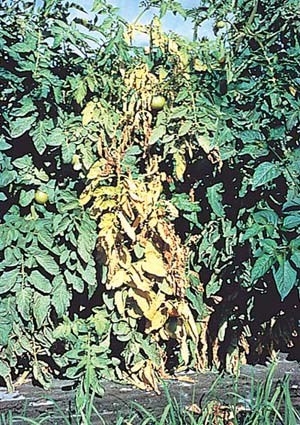
Fusarium wilt is a fungal disease that affects tomato, eggplant and pepper plants. As its name implies, the disease causes the plants to yellow and wilt.
Identification:
Fusarium wilt causes the tomato leaves to turn yellow. In the early stages, one section of the plant may be affected and the leaves will wilt during the heat of the day. As the disease progresses, more of the plant is affected and the leaves turn brown. Eventually, the plant will die. Fusarium wilt is sometimes confused with the less common verticillium wilt. Plants affected with verticillium wilt usually have more uniform yellowing of the leaves on the lower portion of the plant. A diagnostic plant sample can confirm the disease.
The best preventative measures are practicing good gardening methods and growing tomato varieties that are resistant to or less susceptible to fusarium wilt. Good gardening practices include:
- Practice crop rotation and don't plant tomato plants where affected plants grew in the past 3-5 years.
- Sanitize your garden equipment.
- Pull up tomato plants and remove them from the garden in the fall. Infected plants should be burned in an area away from the garden.

Treatment:
Because there is little home gardeners can do to stop the disease once the plants are infected, preventative measures are recommended.
Verticillium Wilt
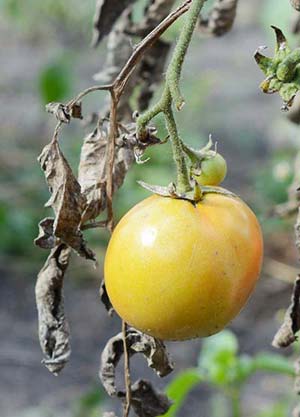
Verticillium wilt is a fungal disease that affects tomato plants as well as pepper, eggplant and potato plants. Common symptoms are the yellowing and wilting of lower leaves of the plants. As the disease progresses, the leaves brown and the plant often dies.
Identification:
Verticillium wilt usually starts in the leaves closest to the ground, and can easily be confused with fusarium wilt. Usually verticillium wilt is more prevalent when temperatures are cool. Plants affected with verticillium wilt usually yellow more slowly and the disease progression is slower. However, as the disease progresses, the leaves will brown. A plant tissue test can diagnose what wilt is affecting your tomato plant.
- Select tomato varieties that exhibit resistance to or are less susceptible to verticillium wilt.
- Practice crop rotation and don't plant tomato plants where peppers, eggplants, potatoes or tomatoes grew in the past two years.
- Avoid stressing plants. Provide them with proper moisture levels and avoid deep cultivation.
- Pull up tomato plants and remove them from the garden in the fall. Infected plants should be burned in an area away from the garden.
- Sanitize garden equipment.

Treatment:
Because there is no cure for verticillium wilt, preventative measures are recommended.
Conclusion
While the list of tomato disease can seem overwhelming, many can be prevented and controlled through good cultural practices. If you are growing tomatoes, follow these simple best practices:
- Rotate crops.
- Plant your tomato plants where they will receive plenty of sun.
- Stake and space them correctly so they have plenty of air circulation.
- Mulch around them and water them at the roots to reduce the spread of disease.
- If possible, select disease-resistant varieties.
- Sanitize your gardening tools.
- Harvest fruits frequently.
- In the fall, remove tomato plants from the garden.
- Finally, make sure to check your tomato plants regularly for signs of disease—and pests.
While this blog focused on tomato plant diseases and treatments, you can find out more about tomato pests at All About Planting Tomatoes and Keeping Insects Away. And, if you grow more than tomatoes, learn more about Garden Insect Control.





 Gardens Alive! & Supplies
Gardens Alive! & Supplies




